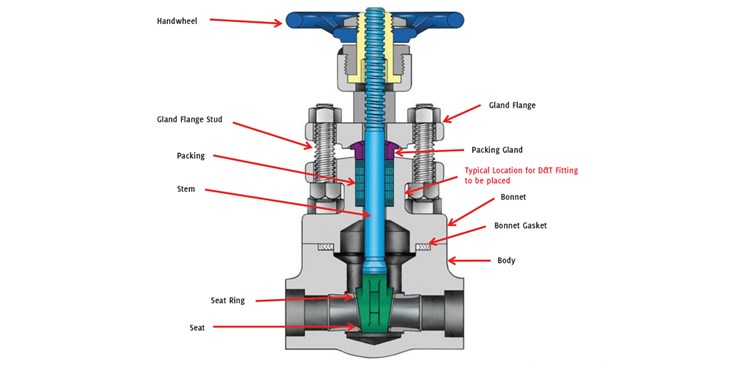The use of the D&T method for packing valves to complete repairs is required by most LDAR programs and Consent Decrees within the 5 to 15 day repair rule before the valve can be placed on the Delay of Repair (DOR) list. Part of LDAR programs or Consent Decree compliance is currently a major topic of discussion.
With more focus now being placed on the midstream market relative to fugitive emissions, the discussion regarding the use of the D&T procedure for leakage control in valves has become a prominent topic of discussion. Even with the long history of D&T repairs in the downstream sector, there is a tremendous amount of push back on its use in the midstream sector.
As a result of the concerns raised by many in the midstream sector regarding the potential required use of the D&T repair method as part of negotiated Consent Decrees, industry experts have met on several occasions to discuss the methodology and how to properly implement the process with regard to safety and continual usage. Additionally, it was discussed what the advantages and disadvantages of using D&T as a repair method for use in the non-traditional valve types used in the midstream market. The U.S. Environmental Protection Agency (EPA) has been involved in some of the discussions, playing a role in helping to identify some key questions that needed to be answered.
Through the various discussions with users, suppliers, service companies and the U.S. EPA, the one topic of discussion that continually came up, was that as long as the D&T process has been used there has not been a true Low Emission injectable packing offered. The injectable products that have been used for the past 60 years were merely designed to offer an immediate fix to gain compliance with either LDAR program guidelines or Consent Decree rules as seen below.
Excerpt from Paragraph 55 of the Flint Hills Consent Decree Regarding the Required Use of Drill and Tap 55. Drill and tap. Except as explicitly provided in Subparagraph 64.b.i, and except for control valves, commencing no later than 90 days after the Date of Entry, when other repair attempts have proven ineffective and/or FHR is not able to remove the leaking valve from service, FHR shall use the “drilland-tap” or equivalent method for fixing valves leaking over 500 ppm, unless FHR can demonstrate that there is a safety, mechanical, product quality, or adverse environmental concern posed by attempting to repair the leak in this manner. FHR shall attempt at least one drill and tap repair (with a second injection of an appropriate sealing material.
If the first injection is unsuccessful before placing the valve (other than provisionally) on the DOR list; however, FHR provisionally may place the valve on the DOR list pending drill and tap if repair efforts have not been successful within 15 days from the initial monitoring event. In no event may FHR take more than 30 days from initial monitoring to finalize its drill and tap repair efforts (with two injections, if necessary). After an unsuccessful drill and tap repair effort (including two injection attempts), FHR may place the leaking valve on its DOR list. If FHR plans to use a new valve repair method not currently in use by the refining and/or chemical industry, FHR will secure EPA’s approval prior to implementing such a method. This Paragraph applies only to the valve packing and/or stem and not to areas on or associated with the valve that cannot be drilled and tapped, such as the bonnet.
Sampling of Drill & Tap forum questions
1. Are end users/valve owners concerned with the valves operability once the Drill & Tap repair has been performed?
2. Is valve metallurgy or manufacturing type (cast vs. forged) a concern when drilling into potentially high-pressure applications commonly seen in the midstream/upstream processes?
3. Is there a concern that the injectable material being used could have petroleum-based lubricants added that could gas off causing false emission readings to occur?
4. Would there be a need to perform testing to API 622/API 624 on the injectable packing materials which would include leakage performance below 100 ppm?
5. Would the use of an injectable packing require the five-year warranty/guarantee commitment written into recent Consent Decree definitions for Low E packing, although not currently considered regarding the injectable products that have been used over the past 60 years?
6. Should valve manufacturers consider testing their new valves with injectable packing and fittings as an additional option for end users to consider when purchasing valves to be used in applications to be monitored as part of LDAR programs or Consent Decrees?
7. Have any of the companies who provide Drill & Tap repair services tested their injectable packing and injection fittings installed on valves as a leak control solution, to validate the ability of these materials to work as Fire Safe materials?
8. Do Drill & Tap repairs perform better on one valve type versus another? (Example: Gate or Globe Rising Stem valves in comparison to Ball or Butterfly Quarter Turn valves)
Conclusion
In early 2019 a product (EZY-PAK Extreme) was released after being tested pursuant to a portion the testing guidelines established as part of API 624 to identify the products ability to meet the Low E compliance requirements established as part of Consent Decrees and LDAR programs throughout the US. EZY-Pak Extreme performed extremely well and met the less than 100 ppm leakage requirements set forth in API 624.
The use of Drill and Tap continues to be included in Consent Decree documents by the U.S. EPA as part of compliance requirements.
Knowing this, it seems obvious that we should work to advance the products being used and the processes by which they are offered to the users to provide a comfort level with regard to the viability of the solution and its effectiveness, while remaining a safe option for all involved.
The goal for all is to meet the requirements and mandates being doled out by the U.S. EPA and other state air quality groups. In addition to meeting the compliance requirements, valves must remain operable affording the users continual operation of their facilities.
This is possible with a concerted effort to work together between valve manufacturers, packing manufacturers and injectable manufacturers.
Compliance is an issue that we should all be working on to help our customers. To do this well, all involved will need to find a way to work together to offer a solution going forward.



